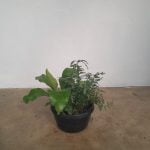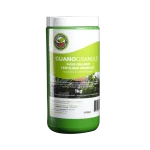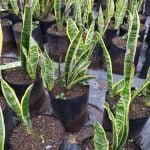Showing 85–96 of 296 resultsSorted by latest
-
Sale!

Mixed Fern Bowl 16cm
Original price was: R325.00.R210.00Current price is: R210.00.Add to cartMixed Fern Bowl 16cm
16cm Bowl filled with assorted fern plants
-
Sale!

Spathiphyllum Sebastian 35cm
Original price was: R995.00.R629.99Current price is: R629.99.Add to cartSpathiphyllum Sebastian 35cm
Common Name: Peace Lily Sebastian -
Sale!

Spathiphyllum Sebastian 30cm
Original price was: R495.00.R349.99Current price is: R349.99.Add to cartSpathiphyllum Sebastian 30cm
Common Name: Peace Lily Sebastian -
Sale!

Peace Lily 20cm Pot
Original price was: R300.00.R215.00Current price is: R215.00.Add to cartSpathiphyllum 20cm Pot
Common Name: Peace Lily, Spathe Flower, White SailsSemi Shade
Bright indirect light
Medium Watering (a good weekly water in summer is best)
Feed Monthly -
Sale!

Swiss Cheese Monster 18cm Pot
Original price was: R350.00.R269.99Current price is: R269.99.Add to cartMonstera Adansonii 18cm Pot
Common Name: Swiss Cheese Delicious MonsterMorning Sun
Bright Indirect Light
Medium Watering
Feed MonthlyMonstera adansonii, commonly known as Swiss Cheese Vine or Monkey Mask, is a popular vining plant belonging to the Araceae family. It is highly valued for its unique foliage, featuring fenestrations (natural holes or splits) in the leaves.
Appearance: They have heart-shaped leaves that are typically dark green and covered in intricate patterns of holes and splits. The fenestrations can vary in size and shape, giving the plant a distinctive and decorative look. The leaves have a glossy texture and can grow to be several inches long.
Growth Habit: Monstera adansonii is a vining plant that can climb or trail, depending on its support. It produces long, trailing stems with aerial roots that allow it to cling to surfaces and climb trees in its natural habitat. It can also be grown in hanging baskets or trained on trellises and moss poles.
Lighting Requirements: The plant thrives in bright, indirect light. It can tolerate lower light conditions but prefers a well-lit location. Avoid exposing it to direct sunlight for extended periods, as it can scorch the leaves. Placing the plant near a window with filtered light is ideal.
Temperature and Humidity: This plant prefers average to warm temperatures between 18-29°C. It can tolerate slightly cooler temperatures but should be protected from drafts and temperature extremes. they appreciate moderate to high humidity levels, so misting the leaves or using a humidifier can be beneficial.
Watering: Keep the soil of the plant evenly moist but not waterlogged. Water the plant when the top inch (2.5 cm) of soil feels slightly dry.
Soil and Fertiliser: Use a well-draining potting mix that retains some moisture. A mixture of peat moss, perlite, and potting soil is commonly used. Fertilise the plant during the growing season (spring and summer) with a balanced, water-soluble fertiliser diluted according to the package instructions.
Pruning and Maintenance: Prune to control its size and shape. Remove any yellowed, damaged, or leggy stems to maintain the plant’s appearance and overall health. Regularly dust or wipe the leaves to keep them clean and promote healthy growth.
Swiss cheese monsters are a visually striking plant that can add a touch of elegance and tropical vibes to your indoor space. With its unique fenestrated foliage and vining growth habit, it is highly sought after by plant enthusiasts. By providing the right care and conditions, you can enjoy its beautiful leaves and potentially witness its trailing vines climbing and cascading in a captivating manner.
-

Ficus Lyrata 31cm Pot (fiddle leaf fig)
R699.99Add to cartFicus Lyrata 31cm Pot (fiddle leaf fig)
Common Name: Fiddle Leaf Fig TreeIndoor
Morning Sun
Shade
Low WateringFicus Lyrata is a wonderful indoor plant.
They need to be kept moist but not sitting in water. Water when top layer of soil is dry.
They enjoy a bright room and can tolerate morning sun only otherwise the leaves may burn.Ficus lyrata, commonly known as the Fiddle Leaf Fig, is a popular and visually striking houseplant. It is known for its large, glossy, violin-shaped leaves.
Appearance: They have large, leathery leaves that are shaped like a fiddle or violin, hence the common name “Fiddle Leaf Fig.” The leaves are dark green and have prominent veins running through them. They can grow to be several inches wide and up to a foot or more in length.
Size: They can grow quite tall and wide in the right conditions. It typically reaches a height of 1 to 3 meters indoors, but it can grow even taller in its native outdoor habitats.
Growth Habit: Ficus lyrata has an upright and bushy growth habit. It develops a single trunk that branches out into a canopy of large leaves. With time and proper care, it can develop a tree-like appearance.
Lighting Requirements: Thrives in bright, indirect light. It prefers a well-lit location, but direct sunlight should be avoided as it can cause leaf burn. Placing the plant near a north-facing or east-facing window where it can receive bright, filtered light is ideal.
Temperature and Humidity: They prefer average to warm temperatures between 15-24°C. It appreciates moderate to high humidity levels, so misting the leaves or using a humidifier can be beneficial, especially in drier indoor environments.
Watering: Keep the soil slightly moist but not waterlogged. Water the plant thoroughly when the top inch (2.5 cm) of soil feels dry. Avoid overwatering, as it can lead to root rot. Ensure proper drainage in the pot to prevent standing water.
Soil and Fertiliser: Use a well-draining potting mix that retains some moisture. A mixture of peat moss, perlite, and potting soil is commonly used. Fertilise the plant during the growing season (spring and summer) with a balanced, water-soluble fertiliser diluted according to the package instructions.
Pruning and Maintenance: Prune to control its size and shape. Remove any yellowed, damaged, or leggy leaves regularly to maintain the plant’s appearance and overall health. Wiping the leaves with a damp cloth occasionally will help keep them clean and dust-free.
Ficus lyrata is a visually stunning plant that can make a bold statement in your indoor space. With its large, distinctive leaves and upright growth habit, it is highly valued by plant enthusiasts. By providing the right care, including proper lighting, watering, and humidity, you can enjoy the beauty of this popular houseplant.
-

GuanoGranule 1kg for Indoor and Potted Plants
R70.00Add to cartGuanoGranule 1kg for Indoor and Potted Plants
The GuanoBoost Pure Organic Granule is a 100% organic Granule made from only natural products to feed your Lawn and Garden.
Simply apply to your lawns, garden and vegetable patches. Activate it with the supporting GuanoBoost liquid to ensure that you have the happiest, healthiest organic plants.
A Complete Garden Nutrition Solution – GuanoBoost is a complete garden nutrition solution that works for lawns, trees, shrubs, veggies, and indoor plants. You only have to use GuanoBoost once a month throughout the year for amazingly healthy green lawns, plants, and trees.
It is all in the Nutrients – GuanoBoost Granules contains all essential nutrients, Humic acid, and organic carbon. ALL the nutrients in GuanoBoost are in the right form that the plant can digest and are immediately available to the plant. It gives the plant an immediate boost of Nutrients, we call this Nutrient Loading! Bigger, better flowering on your trees and flowers
Easy to apply – GuanoBoost granules are SO easy to apply. You just apply the desired amount to your lawn, plants, fruit trees and vegetables for amazing results. Using GuanoBoost Liquid to activate Nutrient Loading.
No more burn – How to ensure you never burn your plants or lawn again, with GuanoBoost because it is 100% organic, it won’t burn your plants.
Safe for Kids and Pets – You CAN have the perfect lawn that is safe for your kids and pets without using harmful chemicals because GuanoBoost only contains Nutrients, not toxins. It is made from 100% natural Sea Bird Guano and a little bit of secret magic, our advanced fermentation process, which brings out the natural fulvic acid and organic carbon.
No more confusion on what Fertiliser to use – Never be confused by fertiliser and plant nutrition again, you simply use GuanoBoost as a Complete garden nutrition solution (works for lawns, trees, shrubs, veggies and indoor plants).
All year round nutrition for the perfect Garden – All living things need nutrition. You feed your body with nutrition continuously why not your plants? GuanoBoost is a complete garden nutrition solution that works for lawns, trees, shrubs, veggies and indoor plants. You only have to use GuanoBoost once a month throughout the year for amazingly healthy green lawns, plants and trees.
LAWNS, SPORTS FIELDS, GOLF COURSE: Apply approximately 1 – 2 kg evenly per 30m2 . Ensure the lawn is cut short and preferably lightly spiked before application.
FRUIT & NUTS: Apply generally 50 g on 5 kg tree / shrub depending on size. Sprinkle evenly in the basin area or in the root zone and mix into the soil with a garden fork approximately 15 cm deep.
FLOWERS: Apply 1kg evenly per 10m2 at the root zone. Avoid spreading the fertiliser on the flowers directly.
VEGETABLES: Apply 20 g per vegetable at planting, by making a small hole next to the plant and cover with soil afterwards. Avoid spreading the fertiliser on the leaves directly.
On ALL of the above, irrigate with water thoroughly after application.GUANOBOOST Granules can be applied once a month.
-
Sale!

Sansevieria Trifasciata ‘Laurentii’ 10lt
Original price was: R325.00.R210.00Current price is: R210.00.Add to cartSansevieria Trifasciata ‘Laurentii’ 10lt
Common Name: Snake Plant, Mother In Laws TongueFull Sun
Semi Shade
Low Watering
Evergreenansevieria trifasciata ‘Laurentii’ is a popular cultivar of the Sansevieria trifasciata species, commonly known as Snake Plant or Mother-in-Law’s Tongue. The ‘Laurentii’ variety is characterized by its tall, upright leaves with bold yellow margins that contrast with the dark green center.
The Snake Plant is a hardy and low-maintenance plant that is widely appreciated for its air-purifying qualities and ability to tolerate a wide range of growing conditions. It is native to West Africa but has become a popular houseplant worldwide.
The ‘Laurentii’ cultivar, with its distinctive yellow-edged leaves, adds a touch of elegance and visual interest to any indoor space. The leaves grow in an erect manner, reaching heights of up to several feet, and have a sword-like shape. The variegation of yellow and green creates a striking and eye-catching display.
As a low-maintenance plant, the Snake Plant is known for its resilience and ability to tolerate neglect. It thrives in various lighting conditions, from bright indirect light to low light, making it suitable for different areas of the home or office. However, it tends to grow more vigorously and maintain its variegation better in brighter light.
In terms of watering, Snake Plants are drought-tolerant and prefer to dry out between waterings. It’s important to avoid overwatering, as they are prone to root rot in overly wet soil. It is generally better to underwater than to overwater these plants. Allow the top inch or so of the soil to dry out before watering again.
Snake Plants are typically potted in well-draining soil to prevent waterlogging. Repotting is usually done when the plant has outgrown its current container or to refresh the soil every few years.
In addition to its attractive appearance, the Snake Plant is known for its air-purifying abilities. It efficiently removes toxins such as formaldehyde, benzene, and xylene from the air, making it a great choice for improving indoor air quality.
Overall, the Sansevieria trifasciata ‘Laurentii’ is a stunning cultivar of the Snake Plant that adds a touch of sophistication to any indoor setting. Its yellow-edged leaves, combined with its easy-care nature, make it a popular choice among plant enthusiasts and beginners alike.
-
Sale!

Sansevieria Trifasciata 10lt
Original price was: R325.00.R210.00Current price is: R210.00.Add to cartSansevieria Trifasciata 10lt
Common Name: Snake PlantSansevieria trifasciata, commonly known as Snake Plant or Mother-in-Law’s Tongue, is a popular and easy-to-grow plant. It is native to West Africa and has become a well-loved houseplant worldwide due to its attractive appearance and low maintenance requirements.
The Snake Plant features long, upright, sword-shaped leaves that are typically dark green with light green horizontal stripes or variegation. There are also other varieties and cultivars available with different leaf patterns and colours. The leaves can grow several feet tall, adding vertical interest to indoor spaces.
One of the reasons for the Snake Plant’s popularity is its ability to tolerate a wide range of growing conditions. It can thrive in both bright indirect light and low light conditions, making it suitable for various areas of the home or office. However, it typically grows more vigorously and maintains its variegation better in brighter light.
In terms of care, the Snake Plant is known for being a low-maintenance plant. It is drought-tolerant and prefers to dry out between waterings. It is important not to overwater the plant, as it is susceptible to root rot in excessively wet soil. It’s generally better to underwater than overwater the Snake Plant. Allow the top inch or so of the soil to dry out before watering again.
Snake Plants are typically potted in well-draining soil to prevent waterlogging. They can tolerate a range of temperatures. They can withstand low temperatures but may suffer damage if exposed to frost or extremely cold conditions.
As for propagation, Snake Plants can be propagated through leaf cuttings or by dividing the rhizomes or underground stems. Leaf cuttings can be placed in water or directly into the soil, and they will develop roots and eventually grow into new plants.
Snake Plants are not only visually appealing but also known for their air-purifying qualities. They efficiently remove toxins such as formaldehyde, benzene, and xylene from the air, making them a great addition to indoor spaces.
In summary, Sansevieria trifasciata, or Snake Plant, is a popular houseplant known for its upright, sword-shaped leaves and low maintenance requirements. Its tolerance for various light conditions, drought resistance, and air-purifying capabilities make it a great choice for both beginner and experienced plant enthusiasts.
-
Sale!

Asplenium Osaka 19cm Pot
Original price was: R195.00.R105.00Current price is: R105.00.Add to cartAsplenium Osaka 19cm Pot
-

Calathea Rufibarba 17cm Pot
R195.00Add to cartCalathea Rufibarba 17cm Pot
Common name: Velvet Calathea -

Hypoestes 14cm Pot
All Indoor Plants, All Plants, Indigenous Plants, Other Indoor Plants, Semi Shade Plants, Shade PlantsR165.00Add to cartHypoestes 14cm Pot
Common Name: Polka Dot PlantBright Indirect Light
Moderate Watering
Monthly FeedingThe Hypoestes plant, also known as the polka dot plant or freckle face plant, is a popular ornamental plant known for its attractive foliage. It belongs to the Acanthaceae family and is native to Madagascar. The scientific name of the most commonly cultivated species is Hypoestes phyllostachya.
The plant is cherished for its eye-catching leaves, which are often covered in colourful spots or dots. The coloration of the leaves can vary, with popular cultivars displaying spots in shades of pink, white, red, or a combination of these colours. The vibrant foliage adds a splash of colour to indoor and outdoor spaces.
This plant is typically grown as an annual in temperate regions but can be cultivated as a perennial in warmer climates. It prefers partial shade or filtered sunlight and thrives in well-draining soil. Regular watering to keep the soil moist but not waterlogged is recommended. Pinching or pruning the plant can help maintain a bushy and compact growth habit.
The Hypoestes plant is often used as a decorative indoor plant, adding charm to homes, offices, and other interior spaces. It can also be incorporated into outdoor gardens and landscapes, either as bedding plants or in containers and hanging baskets. It is valued for its ability to bring a touch of colour and liveliness to any setting.
Propagation of the Hypoestes plant can be done through stem cuttings or by sowing seeds. It is relatively easy to grow and care for, making it a popular choice among both experienced and novice gardeners.
